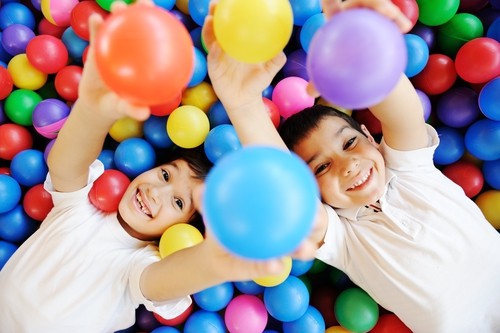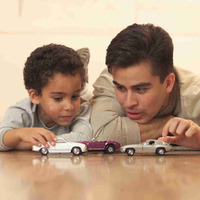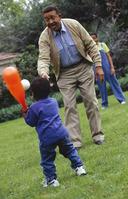 Play activities are essential to healthy development for children and adolescents. Research shows that 75% of brain development occurs after birth. The activities engaged in by children both stimulate and influence the pattern of the connections made between the nerve cells. This process influences the development of fine and gross motor skills, language, socialization, personal awareness, emotional well-being, creativity, problem-solving and learning ability.
Play activities are essential to healthy development for children and adolescents. Research shows that 75% of brain development occurs after birth. The activities engaged in by children both stimulate and influence the pattern of the connections made between the nerve cells. This process influences the development of fine and gross motor skills, language, socialization, personal awareness, emotional well-being, creativity, problem-solving and learning ability.
The most important role that play can have is to help children to be active, make choices and practice actions to mastery. They should have experience with a wide variety of content (art, music, language, science, math, social relations) because each is important for the development of a complex and integrated brain. Play that links sensorimotor, cognitive and social-emotional experiences provides an ideal setting from brain development.
According to Montessori, the essential dimensions of play are:
- Voluntary, enjoyable, purposeful and spontaneous
- Creativity expanded using problem-solving skills, social skills, language skills and physical skills
- Helps expand on new ideas
- Helps the child to adapt socially
- Helps to thwart emotional problems

- Figure out how things work
- Pick up new ideas
- Build muscle control and strength
- Use their imagination
- Solve problems
- Learn to cooperate with others
Play content should come from the child’s own imagination and experiences.
Unfortunately, the play experience for today’s child is often quite different from that of their parents.
With the ever-expanding influence of electronic media including TV, videos, video games, and the internet, child are spending much of their time being passively entertained by or minimally interacting by way of a keyboard or control pad with an electronic device.
Even today’s toys are more often structured by onboard computers that dictate the play experience. This robs children of unstructured play with other kids as well as individual playtime spent in creative play. Parents need to understand the play needs of their child and provide an environment to meet those needs.
Birth-18 months
Almost all neuron (nerve cells) are present at birth but most are not connected in networks. The connecting process (synapse formation) is rapid during this year, with brain activity becoming closer to an adult than newborn by 12 months. Areas of greatest growth are sensorimotor, visual cortex and later the frontal lobes. Play reflects the development of brain areas. This is what Piaget called “practice play.”
Sight, sound, touch, taste, smell: These are the ways babies learn about the world. This is why the best infant toys are usually brightly colored noisemakers. They soon graduate from mobiles (try a musical one for extra interest) and mirrors (which they find fascinating) to grasping and holding. Toys they can manipulate with pleasing effects–activity quilts with different textures: attachments that squeak or jingle; rattles; activity bars: softballs to drop and retrieve–begin to teach them dexterity and the concept of cause-and-effect.
As babies team to sit up, crawl, stand and then walk, the possibilities quickly expand They’re ready to experiment with nesting cups, activity boxes, stacking rings, large blocks, and a little later with shape-sorters. These toys help develop fine motor skills and reach relationships among objects. Cloth or board books, especially intriguing with pictures of faces or familiar objects, let then, practice object-recognition and instill basic ideas of language. Babies and toddlers also love bathtub toys because they delight in all kinds of water play such as filling, emptying, and splashing. And as soon as they’re up on their feet, they’re ready to roll with push-pull toys.
A word of caution: Be sure any toy for a child in this age group has no small pieces that can be removed or broken off and swallowed, no sharp edges or points, and is made of materials.
18 months-3 years
During this age, the synapses continue to expand and reach about 1,000 trillion – twice the density of the adult brain. (Pruning takes place later to reduce the number). The toddler’s brain is twice as active as the adult brain. The structures of the brain that are sensitive to language and social-emotional response develop. Motor development continues at a rapid pace.
Action is the name of the game for toddlers, who delight in running, jumping, climbing and riding. A ride-on toy to zip around on will be a sure-fire hit- whether it’s a low tricycle or a foot-to-floor vehicle in a whimsical bus or car design. Low climbing toys, large balls, and outdoor items like a sandbox or wading pool are also good choices for developing gross motor skills.
Take-apart toys, pop-up toys mid simple puzzles gratify toddlers’ curiosity about how things work, reinforcing their eye-hand coordination and understanding of spatial orientation and cause and effect. One of the best possible toys is that time-tested classic, a good block set: it’s just about the most open-ended, mind-expanding toy made for kids of almost all ages and one that will be used for years. Another creative, tactile-pleasing choice is modeling clay. Tambourines, xylophones, drums and other simple musical instruments are satisfying noisemakers.
Again, be sure toys are made of non-toxic materials, with no sharp edges or points or small parts that can be removed or broken off and swallowed.
3-6 years
This is the fastest growth period for the frontal lobe networks, and speed of processing, memory, and problem solving is increasing. The brain is at 90% of its adult weight by 6 years.
Imagination and interaction play starting roles during the preschool years, and the best toys help set the stage for developing these skills. Things that connect with the experiences kids have are the best for dramatic play.
Opt for a generic unstructured item rather than the single-function brand name version. Play telephones, kitchen appliances, and utensils, tool sets, medical kits. vehicles. dress-up clothes and, of course, baby dolls, as well as toy people and animals all spark the scenarios kids like to construct. Finger or hand puppets offer another way of acting out and mastering day-to-day experiences.
The language and social skills practiced through make-believe games come into play as preschoolers interact more and more. Early board games introduce the concept of taking turns and sharing with others, while letter -, word- and number-recognition toys and games reinforce math and language learning. So, of course, do books, especially if they’re chosen to match the child’s interests.
Art materials (clay, crayons markets, paints, collage materials) are another creative favorite with most children in this age group. And don’t forget jump ropes, larger tricycles and that always-memorable first bike with training wheels.
6-9 years
The synaptic connections in motor and sensory areas are firmly established and the process of elimination synapses (pruning) in these areas has begun. Because of the activity in higher brain “control” centers, children increase in levels of attention and ability to inhibit impulses.
By the time they’re in the primary grades, children have gotten the hang of basic dexterity, language, and social skills; now they’re eager to practice and refine them. They like to challenge themselves, intellectually, with puzzles and games that test their growing knowledge or involve strategy (checkers, card games), and physically, with pick-up sticks, jacks, roller skates, pogo sticks, and ball games.
There are lots of other imaginative options than can broaden this group’s horizons, from craft sets for making jewelry and puppets to a microscope, nature-study kit, or a printing set. You might also turn the passion for collecting that many children develop at this age into a special link between the two of you: for example, by adding a special doll or action figure or set of stamps.
9-14 years
The maturation of the frontal lobe continues in adolescence. (Pruning continues during the stage). The Speed and efficiency of thought increases, spatial working memory improves, emotional regulation becomes greater, planning and problem-solving skills increase, and scientific reasoning and ability to understand one’s own thinking develops. Play becomes sophisticated and increasingly symbolic.
Play in the preteen years often is a group production, and the pastimes kids prefer reflect that. Many complex head games for several players, and equipment for organized sports or activities (baseball bat and glove, racket/paddle games) is often a hit. Electronic games are also popular, played either on en masse or by competitive turns.
At the same time, preteens lavish lots of time and concentration on individual interests, which might include books, music elaborate construction of model- building sets, mature tools, sewing kits, and paints. By this age their tastes and skills are pretty well defined, so targeting toy and entertainment purchases to likes and abilities of each child is important.
As children develop they will move from individual play to group play. How an older child chooses to play may depend on how they feel at the moment or personal preference. The way most children play usually varies from day to day and situation to situation.
There are three basic forms of play:
Solitary Play
Babies usually like to spend much of their time playing on their own. They are exploring all aspects of their environment from the sound of their own voice and the feel of their own body parts to those of others. They want to gaze upon, grab, suck and rattle any object that comes their way.
Older children at times will also prefer to play on their own. They may spend hours making up stories with their GI Joes or Barbie Dolls. They like to build, draw, paint, invent and explore by themselves. They hopefully will also like to read and even write on their own.
Parallel Play
From the age of two to about three, children move to playing alongside other children without much interaction with each other. They may be engaged in similar activities or totally different activities but they like being around others their own age. Even though it may appear that they don’t care about the presence of the other children, just try separating them and you will see this contact from afar is very important to them.
Group Play
By the age of three, children are ready for preschool. They are potty trained, able to communicate and socialize with others. They are able to share ideas and toys. Through interactive play, they begin to learn social skills such as sharing and taking turns. They also develop the ability to collaborate on the “theme” of the play activity. The children not adults should institute play themes and structure. Adults should only intervene when children exhibit the need for coaching on social and problem-solving skills.
Finally, children also like to play with adults. This can be one to one or in a group. It is important that parents spend time playing with their children. It is fun. Let the kids set the pace and become a part of their world. No need to teach or preach, just enjoy the experience.
Note: It is OK for kids to frequently engage in solitary play. However, the need to develop social and communication skills requires a balance. If a child ONLY plays by himself, it may indicate a problem. Don’t hesitate to talk to an expert such as your child’s pediatrician or teacher if you have concerns.
Motor/Physical Play
Motor play provides critical opportunities for children to develop both individual gross and fine muscle strength and overall integration of muscles, nerves, and brain functions. Recent research has confirmed the critical link between stimulating activity and brain development. Young children must have ample opportunities to develop physically, and motor play instills this disposition toward physical activity in young children.
Social Play
A variety of opportunities for children to engage in social play are the best mechanisms for progressing through different social stages. By interacting with others in play settings, children learn social rules such as, give and take, reciprocity, cooperation, and sharing. Through a range of interactions with children at different social stages, children also learn to use moral reasoning to develop a mature sense of values. To be prepared to function effectively in the adult world, children need to participate in lots of social situations.
Constructive Play
Constructive play is when children manipulate their environment to create things. This type of play occurs when children build towers and cities with blocks, play in the sand, construct contraptions on the woodworking bench, and draw murals with chalk on the sidewalk. Constructive play allows children to experiment with objects; find out combinations that work and don’t work; and learn basic knowledge about stacking, building, drawing, making music and constructing. It also gives children a sense of accomplishment and empowers them with control of their environment. Children who are comfortable manipulating objects and materials also become good at manipulating words, ideas, and concepts.
Fantasy Play
Children learn to abstract, to try out new roles and possible situations, and to experiment with language and emotions with fantasy play. In addition, children develop flexible thinking; learn to create beyond the here and now; stretch their imaginations, use new words and word combinations in a risk-free environment, and use numbers and words to express ideas, concepts, dreams, and histories. In an ever-more technological society, lots of practice with all forms of abstraction – time, place, amount, symbols, words, and ideas – is essential.
Games With Rules
Developmentally, most children progress from an egocentric view of the world to an understanding of the importance of social contracts and rules. Part of this development occurs as they learn that games like Follow the Leader, Red Rover, Simon Says, baseball and soccer cannot function without everyone adhering to the same set of rules. The “games with rules” concept teaches children a critically important concept – the game of life has rules (laws) that we all must follow to function productively.
Parents can help playtime to be enjoyable, productive and safe. Here are a few suggestions on how to help your child at play:
Provide a child-centered play area:
- Make sure it is childproof and clean
- Avoid over-stimulation – especially for babies
- Allow children to leave constructions up for a while so they come back and engage in new adventures in the world they created
- Store play items safely but make them easily accessible
Provide toys with play value that:
- Can be used in many ways
- Allow children to determine the play
- Appeal to children at more than one age or level of development
- Can be used with other toys for new and more complete play
- Will stand the test of time and continue to be part of play as develop new interest and skills
- Help children develop skills important for further learning and a sense of mastery
Encourage a balance in play activities:
- Reduce or eliminate screen time (1 or 2 hours per day max)
- Encourage outdoor play that uses large muscles – running, jumping, climbing and playing games is cool
- Curtail time spent in adult-organized activities – kid-directed play is important
- Don’t allow your child to become over-scheduled – self-directed play should be encouraged
- Encourage new activities such as art, music, building or science – you make the introduction then let them on their own (some will make a hit others won’t and that’s OK)
- How about letting them work? – kids enjoy helping in the kitchen and in the yard – give younger children junior sized appliances, tools and equipment so they can “work” beside you
 While children do need time to play alone and with other children without adult intervention, research shows that playtime with parents is also important.
While children do need time to play alone and with other children without adult intervention, research shows that playtime with parents is also important.
Children crave time with parents. It makes them feel special. Parents are encouraged to find time to spend playing with their kids on a regular basis. This should include one to one with each child and group time with all of the adults and kids in the home. If you are a single parent or have an only child, occasionally invite family or friends over to play.
In pretend play, let the child develop the theme. Get into their world. Let them go with it. Ask questions. Play along. Be silly along with them and have fun. Avoid over-stimulation. Know when it is time to stop.
Also, when appropriate, parents can use stuffed animals or puppets to act out real-life situations that can teach problem-solving or social skills. Let the puppet demonstrate the wrong way to handle a situation. Then, along with input from the child, act out a better way. Afterward, let the child do the same.
More Possibilities:
- Play outdoors. Throw balls. Push kids on swings. Make mud pies. Go on a hike around the neighborhood. Take a nature walk in your backyard.
- Play games – card games – board games – silly and wacky kids games. Help them learn to take turns, how to win and how to lose. Praise them. Encourage them. Laugh with them.
- Get involved in a craft project together. Build a jigsaw puzzle as a family. Bake cookies. Paint a picture.
- Listen to music together. Sing along. Play rhythm instruments along with the music. Get out the guitar or keyboard and make music.
- Read a book together. Ask questions. Ask them to change the story or make up a new one.
- Watch a movie together. Find out what they liked – how they felt. Discover the child’s interests. Comment on and discuss any bothersome content either words or actions.
- Play kid games like: Follow the Leader – Guess What I Am? – Hide and Seek
Help kids when they show the need it or ask for it. Use it as a time to teach:
- patience
- problem solving
- social skills
- creativity

Playing with kids builds a bond that will last forever. It lets the child know he or she is loved and appreciated. It opens the door for sharing problems and concerns when the need arises. It helps the parent get to know and under the uniqueness of each child. It is also a great stress reducer for overworked parents.
Family Activities are great for the whole family. They help develop strong family bonds which can last a lifetime. It can be said that a family who plays together stays together. They also are more cooperative, supportive and have open communication. These qualities pay off in big dividends by increasing self-esteem, social skills and a sense of connectedness that helps kids and teens use good judgment when confronted with difficulties and temptations.
Family Game Night:
Here’s a great tradition that is easy to start. Pick a night and make it a family game night. Gradually add games that can be fun for the entire family. Take turns choosing the game to play. Make sure the games are appropriate for the youngest player. A great time to bond through friendly competition. Learn how to take turns and play fair. Learn how to be a good loser and well as a good winner.
Encourage Outdoor Activities

Now is the time to stop the “Couch Potato” syndrome. Pediatricians find that most kids are not getting enough exercise. Parents can be good role models by going outside and playing along with their kids. Hey, it is good for adults as well. Encourage your child to be active. Help them develop motor coordination and learn good sportsmanship.
Most children have little trouble expressing their creativity. Just ask any mother who has had to clean crayons and markers off of a freshly painted wall. Providing toys that allow your child to get creative encourage imagination and allow her to learn by doing. Creativity isn’t just about artwork. It can be expressed in a number of ways. Here are some of the best toys for encouraging creativity in your child.
Building Toys
Blocks of any kind are great for kids of all ages. They can be used to build almost anything your child can imagine. Legos allow kids to make more durable masterpieces, but it’s important to get the big ones for children who still like to put things in their mouths. There are also other types of building toys, such as the magnetic K’nex, that allow greater flexibility and different ways to build. There are even kits that allow older kids to build their own remote control cars. [Find Building Toys]
Art Toys
Drawing is a favorite activity for many children. You can encourage your budding artist by giving the toys that make it easy to express herself. Washable markers make messes more bearable. Magnetic drawing boards, Etch-a-Sketches, and other toys that allow drawing without using crayons or markers eliminate the mess altogether and are great for travel. Finger paint is a favorite of young artists, but it can be messy. Letting your kids indulge in it once in a while is good for them, and with some preparation, you can avoid any permanent damage. Smocks and lots of newspaper will protect their clothes and your table. [Find Art Toys]
Musical Toys
Music is a wonderful learning tool for children, and it’s even better when they make it themselves. You can find durable toy instruments for even the youngest budding musician. Babies love plastic tambourines, maracas, and xylophones. Toddlers and preschoolers can play a kazoo or recorder. If your child expresses great interest in the piano, beginner piano lessons might be a good investment. Children who love to sing might enjoy a karaoke machine. There are also microphones that do special effects so your little singer can sound like a pro. And there are lots of sing-a-long CDs, DVDs, and toys available. [Find Musical Toys]
Craft Kits
There are all sorts of crafts that kids can do. Kits that come with everything needed for a specific craft project make crafting easy. You could buy individual craft items and let your kids’ imaginations take over. Creativity comes naturally for kids. Giving them toys that help them express themselves is a great way to encourage them to do so. Kids who are allowed to be creative often have a greater interest in learning and as a result, they are more likely to do their best in school and life. [Find Craft Toys]


